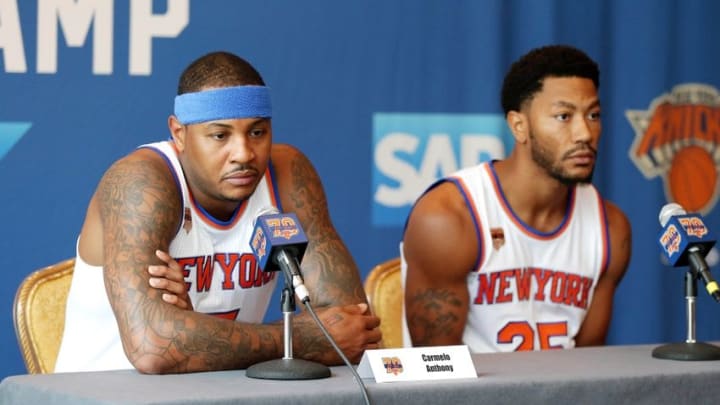Phil Jackson and the New York Knicks have built a promising new roster, but it may take longer than expected for team chemistry to be developed.
We know the names. We’ve read about the trades and analyzed the signings. The 2016-17 New York Knicks look nothing like the 2015-16 New York Knicks.
One would assume adding Derrick Rose and Joakim Noah to a 32-win team will produce immediate, positive results. Unfortunately, that may not be the case due to the Knicks’ extreme lack of roster continuity.
We can very easily determine a team’s roster continuity by calculating the percentage of returning minutes from last season.
The Knicks brought back 7 players who accounted for 9,030 of the team’s 19,805 minutes in 2015-16, so the team’s roster continuity sits at 45.6%. This would be the league’s worst if not for the Brooklyn Nets, who find themselves with just 30.8% of last season’s minutes returning after essentially rebuilding the entire team this offseason.
This is relatively troubling.
The Knicks roster continuity this season is nearly identical to that of the post-Decision Miami Heat, and even with one of the most loaded rosters in NBA history, we watched the team struggle with chemistry for most of the 2010-11 season. Yes, they reached the NBA Finals. They had LeBron James.
Teams with James seem to prove that roster continuity is irrelevant because, well, they have LeBron James! The man is a human ticket to the NBA Finals. But we’ve seen that chemistry takes time—sometimes an entire season for a team to truly coalesce—even when equipped with a transcendent talent like James.
The Heatles recovered and returned 79% of their minutes on their way to James’ first title in 2011-12.
James’ return to Cleveland created yet another “super team” overnight. As we observed with the Heat (and the Knicks), teams simply cannot add multiple marquee players without shaking up the entire roster. The 2014-15 Cavaliers returned just 39% of the previous season’s minutes.
One could argue that the Cavs could have taken down the Warriors with a healthy Kyrie Irving and Kevin Love, but the team’s chemistry issues were well-documented.
This past season, the Cavs returned 84% of their minutes (while, admittedly, still struggling with chemistry). James began to include Love in his post game #squadgoals Instagram posts, and the team took down the mighty Golden State Warriors, who blew a 3-1 lead, in case you haven’t heard.
Since 2010-11, the average playoff team returned 69% of the previous season’s minutes. The average champion returned over 80%.
Of course, the comparisons between LeBron’s championship squads and the current Knicks team begin and end with initial roster continuity. The point is that uber talented teams assembled overnight with built-in high expectations and minimal roster continuity can take a full season or more to truly figure out how to best operate.
The fact is simply that successful teams take time to build.
Since 2010-11, the average playoff team returned 69% of the previous season’s minutes. The average champion returned over 80%. There isn’t much of a precedent for success for a team that experienced as much roster turnover as the Knicks have over a single offseason.
Must Read: 5 burning questions following the conclusion of the 2016 NBA preseason
We certainly have reason to believe this team will struggle out of the gate. Patience is key, even for “super teams.”
